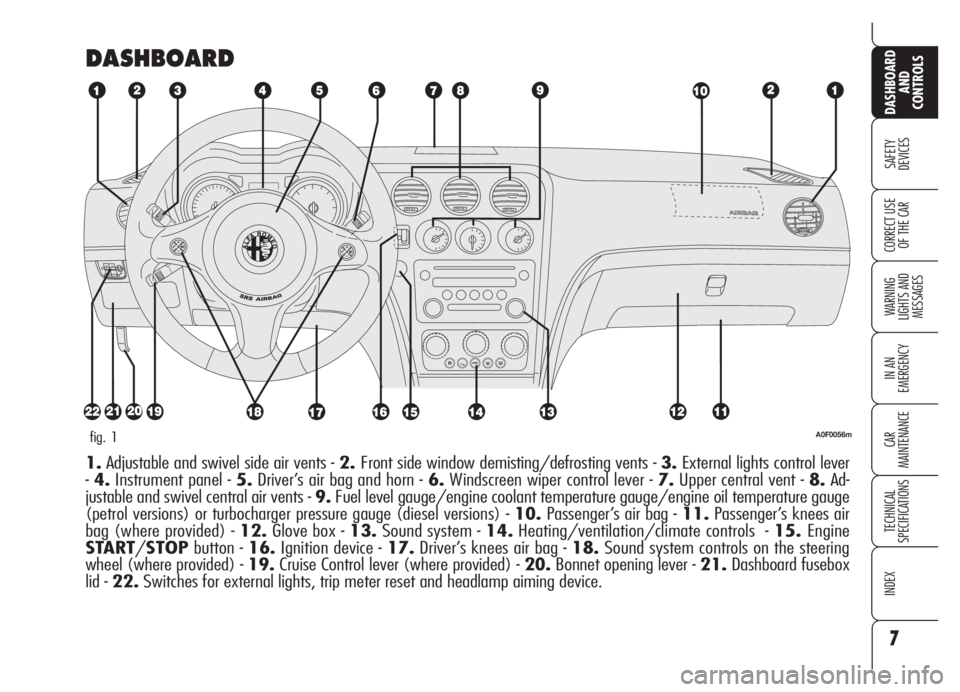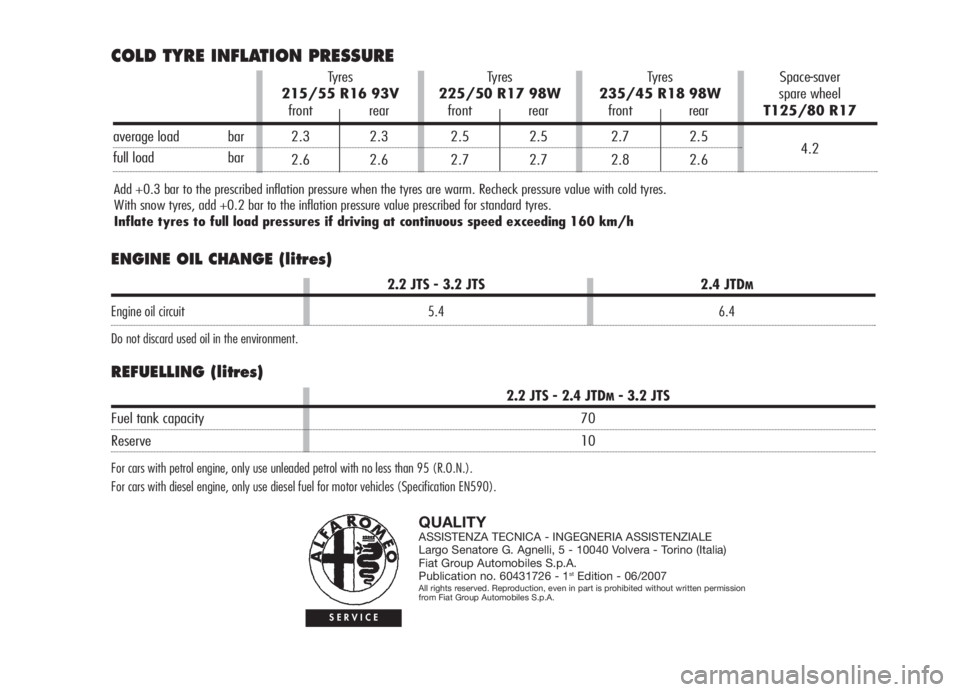2008 Alfa Romeo Brera/Spider fuel pressure
[x] Cancel search: fuel pressurePage 8 of 270

7
SAFETY
DEVICES
WARNING
LIGHTS AND
MESSAGES
IN AN
EMERGENCY
CAR
MAINTENANCE
TECHNICAL
SPECIFICATIONS
INDEX
DASHBOARD
AND
CONTROLS
CORRECT USE
OF THE CAR
DASHBOARD
A0F0056mfig. 1
1.Adjustable and swivel side air vents - 2.Front side window demisting/defrosting vents - 3.External lights control lever
-4.Instrument panel - 5.Driver’s air bag and horn - 6.Windscreen wiper control lever - 7.Upper central vent - 8.Ad-
justable and swivel central air vents - 9.Fuel level gauge/engine coolant temperature gauge/engine oil temperature gauge
(petrol versions) or turbocharger pressure gauge (diesel versions) - 10.Passenger’s air bag - 11.Passenger’s knees air
bag (where provided) - 12.Glove box - 13.Sound system - 14.Heating/ventilation/climate controls - 15.Engine
START/STOPbutton - 16.Ignition device - 17.Driver’s knees air bag - 18.Sound system controls on the steering
wheel (where provided) - 19.Cruise Control lever (where provided) - 20.Bonnet opening lever - 21.Dashboard fusebox
lid - 22.Switches for external lights, trip meter reset and headlamp aiming device.
Page 26 of 270

25
SAFETY
DEVICES
WARNING
LIGHTS AND
MESSAGES
IN AN
EMERGENCY
CAR
MAINTENANCE
TECHNICAL
SPECIFICATIONS
INDEX
DASHBOARD
AND
CONTROLS
CORRECT USE
OF THE CAR
AUTOMATIC INSTRUMENT
PANEL LIGHT DIMMER
To give max. visibility and comfort un-
der whatever driving conditions (e.g.:
lights on in daylight, tunnels, etc…), the
speedometer is fitted with a sensor for
adjusting automatically, after fitting the
electronic key into the ignition device and
pressing button START/STOP, the
light intensity of the instrument panel dis-
play, sound system display, climate con-
trol system display, radionavigation sys-
tem display (where provided), and in-
struments (i.e.: fuel level gauge, engine
oil temperature gauge for petrol versions
or turbocharger pressure gauge for diesel
versions, and engine coolant temperature
gauge).
TRIP METER RESET fig. 19
To reset the trip meter, keep button A
pressed for a few seconds.
MANUAL INSTRUMENT
PANEL LIGHT DIMMER
With this function it is possible to adjust
on 8 levels the light intensity of the indi-
cations given on the instrument panel dis-
play, sound system display, climate con-
trol system display, radionavigation sys-
tem display (where provided), and in-
struments (i.e.: fuel level gauge, engine
oil temperature gauge for petrol versions
or turbocharger pressure gauge for diesel
versions, and engine coolant temperature
gauge).
To increase light intensity press briefly
button+on the left-hand stalk, to re-
duce it press button –: the display will
show an indication and a figure corre-
sponding to the current light intensity
level. This screen will be displayed for
a few seconds and then it will go off.
A0F0072mfig. 19
Page 39 of 270

38
SAFETY
DEVICES
WARNING
LIGHTS AND
MESSAGES
IN AN
EMERGENCY
CAR
MAINTENANCE
TECHNICAL
SPECIFICATIONS
INDEX
DASHBOARD
AND
CONTROLS
CORRECT USE
OF THE CAR
Values displayed
Average consumption
Represents the indicative average of con-
sumptions from the beginning of the
new mission.
Current consumption
This value shows instant fuel consump-
tion (this value is updated second by
second). If parking the car with engine
on, the display will show “- - - -”.
Average speed
This value shows the car average speed
as a function of the overall time elapsed
since the start of the new mission.
Travel time
This value shows the time elapsed since
the start of the new mission (driving
time).Range
This value shows the distance in km (or
mi) that the car can still cover before
needing fuel, assuming that driving con-
ditions are kept unvaried.
The display will show “- - - -“ in the fol-
lowing cases:
❒value lower than 50 km (or 30 mi);
❒car left parked with engine running
for long.
IMPORTANTThe variation of the au-
tonomy value can be influenced by dif-
ferent factors: driving style (see what is
described in paragraph “Driving style”
in the chapter “Correct use of the car”),
type of route (highways, urban, moun-
tain, etc…), use conditions of the car
(load transported, tire pressure, etc…).
What was described previously must be
taken in consideration when planning
a trip.
Travel Distance
This value shows the distance covered
from the start of the new mission.
Each time the battery is connected and
each time a new mission is started (re-
set), the display will show “0.0”. The “General Trip” displays the figures
relating to:
❒Average consumption
❒Current consumption
❒Average speed
❒Travel time
❒Range
❒Travel Distance
“Trip B” displays information concern-
ing :
❒Travel Distance B
❒Average consumption B
❒Average speed B
❒Travel time B.
Page 154 of 270

153
SAFETY
DEVICES
WARNING
LIGHTS AND
MESSAGES
IN AN
EMERGENCY
CAR
MAINTENANCE
TECHNICAL
SPECIFICATIONS
INDEX
DASHBOARD
AND
CONTROLS
CORRECT USE
OF THE CAR
W W
A A
R R
N N
I I
N N
G G
L L
I I
G G
H H
T T
S S
A A
N N
D D
M M
E E
S S
S S
A A
G G
E E
S S
LOW BRAKE FLUID/
HANDBRAKE ON ................................................. 155
BRAKE PAD WEAR ............................................. 155
SEAT BELTS NOT FASTENED ................................. 155
AIR BAG FAILURE................................................ 156
PASSANGER’S FRONT AIR BAGS DEACTIVATED ........ 157
ENGINE COOLANT HIGH TEMPERATURE.................. 157
ENGINE OIL HIGH TEMPERATURE .......................... 158
LOW ENGINE OIL PRESSURE/ EXHAUST OIL .......... 158
LOW BATTERY CHARGE ....................................... 158
INCOMPLETE DOOR LOCKING ............................... 159
BONNET OPEN ................................................... 159
BOOT OPEN....................................................... 159
INJECTION SYSTEM FAILURE/
EOBD SYSTEM FAILURE....................................... 159
CAR PROTECTION SYSTEM FAILURE/
STEERING LOCK INHIBITION................................. 160
ALARM FAILURE/BREAK-IN ATTEMPT/
ELECTRONIC KEY NOT RECOGNIZED ...................... 160
POSSIBLE PRESENCE OF ICE ON THE ROAD............ 161
PRE-HEATING GLOW PLUGS/
PRE-HEATING GLOW PLUG FAILURE ....................... 161
WATER IN DIESEL FUEL FILTER ............................. 162INERTIAL FUEL CUT-OFF SWITCHED ON ................. 162
ABS SYSTEM FAILURE......................................... 162
EBD SYSTEM FAILURE......................................... 163
VDC SYSTEM .................................................... 163
HILL HOLDER FAILURE ........................................ 163
ASR SYSTEM (WHEEL ANTISKID SYSTEM) ............. 163
EXTERNAL LIGHTS FAILURE .................................. 164
BRAKE LIGHTS FAILURE ....................................... 164
REAR FOGLIGHTS ............................................... 164
FRONT FOG LIGHTS ............................................ 164
SIDE/TAILLIGHTS/FOLLOW ME HOME .................. 164
DIPPED BEAM HEADLIGHTS.................................. 164
MAIN BEAM HEADLIGHTS .................................... 164
LEFT-HAND DIRECTION INDICATOR ........................ 165
RIGHT-HAND DIRECTION INDICATOR ...................... 165
LIGHT SENSOR FAILURE........................................ 165
RAIN SENSOR FAILURE......................................... 165
PARKING SENSORS FAILURE ................................ 165
FUEL RESERVE - LIMITED CRUISING RANGE ............ 165
CRUISE CONTROL .............................................. 165
DIESEL PARTICULATE FILTER CLOGGED .................. 166
ANTIPINCH SYSTEM FAILURE ............................... 166
WINDSCREEN WASHER FLUID LOW LEVEL ............. 166
SPEED LIMIT EXCEEDED ...................................... 166
T.P.M.S. SYSTEM FAILURE ................................... 166
CHECK TYRE PRESSURE ...................................... 167
LOW INFLATION PRESSURE ................................. 167
TYRE PRESSURE UNSUITABLE FOR SPEED ............. 167
Page 212 of 270

211
SAFETY
DEVICES
WARNING
LIGHTS AND
MESSAGES
IN AN
EMERGENCY
CAR
MAINTENANCE
TECHNICAL
SPECIFICATIONS
INDEX
DASHBOARD
AND
CONTROLS
CORRECT USE
OF THE CAR
30 60 90 120 150 180
●●●●●●
●●●●●●
●●●●●●
●●●●●●
●●●●●●
●●●
●●●●●●
●●●●●●
●●●●●●
●●●
●●
SERVICE SCHEDULE
Thousands of km
Check tyre conditions/wear and
adjust pressure if required
Check light system operation (headlights, direction indicators,
hazard lights, boot lights, passenger compartment lights,
glovebox lights, warning lights, etc.)
Check windscreen wiper/washer operation,
adjust nozzles if required
Check windscreen/rear window blade
position/wear
Check front disk brake pad conditions and wear
and wear indicator operation
Check rear disk brake pad conditions and wear
Sight inspect the conditions of: body external parts,
underbody protection, pipes and hoses (exhaust - fuel -
brakes), rubber parts (boots, sleeves, bushes, etc.)
Check cleanness of locks, bonnet and boot and lever cleanness
and lubrication
Check and top up, if required, fluid levels (brakes/hydraulic
clutch, power steering, windscreen washer, battery,
engine coolant, etc.)
Check and adjust handbrake lever stroke
Sight inspect accessory drive belt conditions
Page 214 of 270

213
SAFETY
DEVICES
WARNING
LIGHTS AND
MESSAGES
IN AN
EMERGENCY
CAR
MAINTENANCE
TECHNICAL
SPECIFICATIONS
INDEX
DASHBOARD
AND
CONTROLS
CORRECT USE
OF THE CAR
USE OF THE CAR
UNDER HEAVY
CONDITIONS
Should prevailing use of the car be un-
der one of the following specially heavy
conditions:
❒trailer or caravan towing;
❒dusty roads;
❒short distances (less than 7-8 km)
and repeated with external temper-
atures below zero;
❒frequently idling engines or long dis-
tance low speed driving (e.g.: door-
to-door deliveries) or in case of a long
term inactivity;
❒urban routes;
carry out checks more frequently than
required on Service Schedule:
❒check front disk brake pad conditions
and wear;
❒check cleanness of bonnet and boot
locks and lever cleanness and lubri-
cation;
❒sight inspect the conditions of: en-
gine, gearbox, transmission, pipes
and hoses (exhaust - fuel - brakes),
rubber parts (boots, sleeves, bushes,
etc.);
❒check battery charge and fluid level
(electrolyte);
❒visual check on various drive belt con-
ditions;
❒change engine oil and oil filter, if re-
quired;
❒check and replace pollen filter, if re-
quired;
❒check and replace air cleaner, if re-
quired.
PERIODICAL CHECKS
Every 1,000 km or before long jour-
neys, check and top up if required:
❒engine coolant fluid level;
❒brake fluid level;
❒windscreen washer fluid level;
❒tyre pressure and conditions.
❒check light system operation (head-
lights, direction indicators, hazard
lights, etc.);
❒check windscreen wiper/washer op-
eration and windscreen/rear window
blade position/wear;
Every 3,000 km check and top up if re-
quired: engine oil level.
You are recommended to use FL Sele-
nia products, designed and produced
specifically for Alfa Romeo cars (see
table “Capacities” in section “Techni-
cal specifications”).
Page 269 of 270

ENGINE OIL CHANGE (litres)
REFUELLING (litres)
QUALITYASSISTENZA TECNICA - INGEGNERIA ASSISTENZIALE
Largo Senatore G. Agnelli, 5 - 10040 Volvera - Torino (Italia)
Fiat Group Automobiles S.p.A.
Publication no. 60431726 - 1
stEdition - 06/2007All rights reserved. Reproduction, even in part is prohibited without written permission
from Fiat Group Automobiles S.p.A.
SERVICE
2.2 JTS - 3.2 JTS 2.4 JTDM
Engine oil circuit 5.4 6.4
Do not discard used oil in the environment.
COLD TYRE INFLATION PRESSURE
Add +0.3 bar to the prescribed inflation pressure when the tyres are warm. Recheck pressure value with cold tyres.
With snow tyres, add +0.2 bar to the inflation pressure value prescribed for standard tyres.
Inflate tyres to full load pressures if driving at continuous speed exceeding 160 km/h
2.2 JTS - 2.4 JTDM- 3.2 JTS
Fuel tank capacity 70
Reserve 10
For cars with petrol engine, only use unleaded petrol with no less than 95 (R.O.N.).
For cars with diesel engine, only use diesel fuel for motor vehicles (Specification EN590).
Tyres
215/55 R16 93V
front rear
2.3 2.3
2.6 2.6Space-saver
spare wheel
T125/80 R17
4.2 Tyres
225/50 R17 98W
front rear
2.5 2.5
2.7 2.7Tyres
235/45 R18 98W
front rear
2.7 2.5
2.8 2.6
average load bar
full load bar